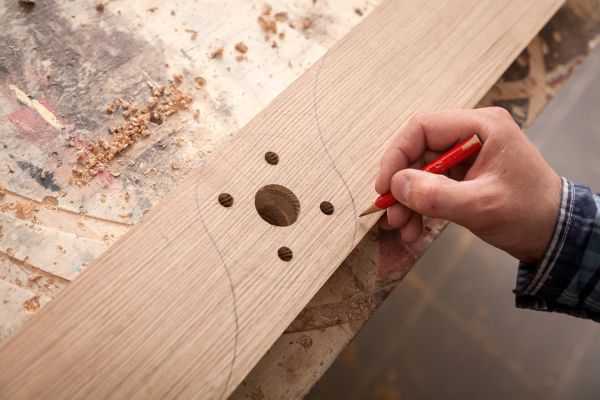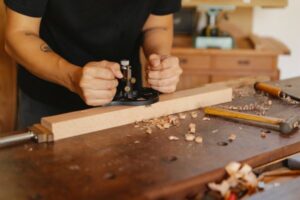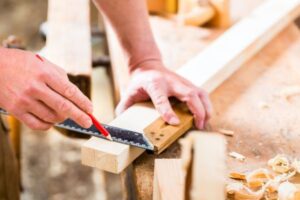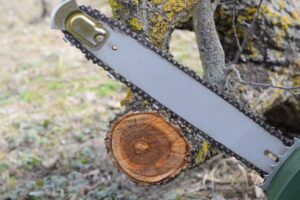Woodworking is a timeless craft that allows artisans to transform raw timber into beautiful and functional pieces of furniture, art, and more. While modern machinery and power tools have their place in the workshop, hand tools remain essential for any serious woodworker. These traditional tools not only offer precision and control but also a deep connection to the craft’s roots. In this comprehensive guide, we will explore 20 essential hand tools for woodworking, each playing a crucial role in shaping, cutting, and finishing wood.
Chisels
Chisels are fundamental hand tools in woodworking, used for cutting and shaping wood. They come in various sizes and shapes, with bevel-edge chisels being the most common. Chisels are employed for tasks such as removing waste wood in joints, carving intricate details, and creating mortises. Proper sharpening and honing techniques are essential to maintain their effectiveness.
Chisels are typically made of high-carbon steel or high-speed steel, and their handles can be made of wood or synthetic materials. A good set of chisels should be a cornerstone of any woodworking toolkit, allowing for precise, controlled cuts.
Hand Planes
Hand planes are indispensable for flattening and smoothing wood surfaces. They come in various types, including bench planes, block planes, and specialty planes. Bench planes are used for removing rough surfaces and achieving flatness, while block planes are handy for fine finishing work and chamfering edges. Specialty planes like router planes and shoulder planes are used for specific tasks.
Hand planes require proper setup and sharpening to achieve optimal results. They consist of a blade (iron) and a sole (base), which must be in perfect alignment for effective use. The rhythmic sound of a well-tuned hand plane gliding across wood is music to a woodworker’s ears.
Backsaws
Backsaws are precision saws designed for accurate, clean cuts in woodworking. Unlike standard hand saws, backsaws have reinforced backs to prevent bending during use, ensuring straight cuts. Popular types of backsaws include dovetail saws, tenon saws, and carcass saws, each suited to specific tasks.
Dovetail saws are used for cutting intricate joints, while tenon saws excel at cutting tenons and other larger joints. Carcass saws are versatile and suitable for various woodworking tasks. Backsaws, when used with care and skill, produce clean, tight-fitting joints—a hallmark of quality craftsmanship.
Coping Saws
Coping saws are designed for making intricate curved cuts in wood, making them indispensable for tasks like cutting intricate scrollwork, curves, and detailed joinery. These saws consist of a thin, flexible blade stretched between a U-shaped frame. The frame can be adjusted to various angles, allowing for versatile cutting.
Coping saw blades come in different tooth counts and are easily replaceable. When used with finesse, coping saws are capable of creating intricate shapes and contours, making them a must-have tool for woodworkers who value precision and creativity in their projects.
Hand Files and Rasps
Hand files and rasps are essential for shaping and smoothing wood surfaces by removing material efficiently. These tools come in various shapes and sizes, with different cuts (tooth configurations) for specific applications. Hand files are flat, while rasps have a more aggressive tooth pattern.
Woodworkers use hand files and rasps to shape curves, refine edges, and remove rough spots. Their versatility makes them valuable tools for achieving a polished finish on wood projects. A well-maintained set of hand files and rasps can last a lifetime and contribute to the quality of your woodworking endeavors.
Mallets
Mallets are wooden or rubber-headed tools used to strike chisels, carving tools, and other implements, ensuring controlled and precise cuts. Unlike hammers, mallets are designed to deliver force without causing damage to delicate tools or workpieces.
Woodworkers choose mallets based on the task at hand. A wooden mallet is commonly used for chiseling and carving tasks, as it transmits the energy efficiently without transferring shock to the user’s hand. Rubber or plastic mallets are preferred for assembling joinery, as they are less likely to mar the wood’s surface.
Marking and Measuring Tools
Accurate measurements and precise markings are crucial for woodworking projects. A set of reliable marking and measuring tools is essential for ensuring that your cuts and joints are precise. Some essential marking and measuring tools include:
Tape measures: Used for measuring lengths and dimensions accurately.
Combination squares: Ensure perfect 90-degree and 45-degree angles.
Marking gauges: Used to scribe lines parallel to the wood’s edge.
Try squares: Ensure that your cuts and joinery are square and accurate.
Sliding bevel gauges: Used for marking and transferring angles.
Compass and dividers: Essential for marking curves and circles.
Block Planes
Block planes are compact hand planes used for various tasks such as chamfering edges, smoothing end grain, and fine-tuning joints. They are small enough to be held with one hand and are extremely versatile, making them a valuable addition to any woodworker’s toolkit.
Block planes have an adjustable mouth, allowing you to control the size and thickness of the shaving, which is crucial for achieving a smooth finish. With their portability and ease of use, block planes are a go-to tool for woodworkers when precision is required.
Spokeshaves
Spokeshaves are specialized hand tools designed for shaping and smoothing curved surfaces, such as chair legs or rounded edges. They consist of a blade housed in a metal body with handles for control. Spokeshaves are available in flat-bottom and round-bottom configurations, allowing for versatility in shaping.
Woodworkers appreciate spokeshaves for their ability to create smooth, consistent curves. Whether you’re shaping a spindle or fine-tuning an intricate curve, these tools are essential for achieving precision in woodworking projects.
Clamps
Clamps are indispensable tools for holding workpieces securely during various woodworking tasks, including gluing, assembly, and joinery. They come in a variety of styles, including bar clamps, pipe clamps, C-clamps, and spring clamps, each suited to specific applications.
Clamps ensure that your pieces are aligned correctly and that joints are tightly bonded during glue-ups. Having a variety of clamps in your workshop is essential for tackling a wide range of projects and ensuring that your workpieces remain stable and accurate throughout the woodworking process.
Carving Tools
Carving is a specialized aspect of woodworking that requires a unique set of hand tools. Carving tools, including gouges, chisels, and carving knives, are essential for creating intricate designs, patterns, and decorative elements on wood surfaces.
Woodcarvers use a combination of different carving tools to achieve depth, texture, and fine details in their projects. The ability to sculpt wood with precision and artistry is a testament to the skill and creativity of woodworkers who specialize in carving.
Screwdrivers
Screwdrivers are indispensable for assembling and disassembling woodworking projects. While they may not be directly involved in shaping wood, they are essential for securing components such as hinges, knobs, and fasteners.
A set of high-quality screwdrivers, both flathead and Phillips, should be readily available in your workshop. Their ergonomic handles and durable tips ensure that you can efficiently install hardware and complete your woodworking projects with ease.
Scrapers
Scrapers are essential for achieving a smooth, glass-like finish on wood surfaces. These tools consist of a flat, thin piece of metal with a sharp edge, which is used to remove fine shavings of wood and eliminate any imperfections in the surface.
Scrapers are particularly useful for dealing with difficult wood grain patterns, reversing tear-out, and preparing surfaces for finishing. When properly sharpened and used, they can leave your woodwork with an exceptionally smooth and polished appearance.
Woodworking Miter Box
A miter box is a tool used for making accurate crosscuts and angled cuts in wood. It provides a stable guide for saws, ensuring that cuts are precise and at the desired angles. Miter boxes come in various sizes and designs, including simple plastic ones for basic tasks and more robust models for professional use.
Woodworkers rely on miter boxes to create perfect 45-degree and 90-degree cuts, which are essential for assembling frames, moldings, and other woodworking components. The miter box helps maintain accuracy, especially when working on projects that require precise angles.
Woodworking Vises
Woodworking vises are essential for securely holding workpieces in place while you work on them. Whether you’re planing, sawing, or chiseling, a vise provides stability and safety, preventing the wood from moving or shifting during the process.
Woodworking vises come in various styles, including bench vises, front vises, and tail vises, each suited to specific tasks. A sturdy and well-installed vise is a valuable addition to your workbench, allowing you to work efficiently and with greater control.
Japanese Pull Saws
Japanese pull saws, also known as “Nokogiri” in Japanese, are prized for their exceptional cutting precision and minimal kerf (the width of the cut). Unlike Western saws, Japanese pull saws cut on the pull stroke, resulting in cleaner and more accurate cuts.
These saws are available in various blade lengths and tooth configurations, making them suitable for a wide range of woodworking tasks. Japanese pull saws are particularly valued for their ability to make delicate and precise cuts, making them a favorite among fine woodworking enthusiasts.
Scraping Planes
Scraping planes, also known as cabinet scrapers or card scrapers, are tools designed for fine finishing and smoothing of wood surfaces. They consist of a small metal plate with a sharp edge, which is used to scrape away wood fibers and imperfections.
Scraping planes are excellent for removing tear-out, smoothing intricate profiles, and preparing wood surfaces for finishing. Their versatility and ability to produce a glass-smooth surface make them indispensable for achieving the highest level of craftsmanship in woodworking.
Burnishing Tools
Burnishing tools are used in conjunction with cabinet scrapers to create a finely honed edge on the scraper’s blade. These tools are essential for maintaining the sharpness of the scraper and ensuring that it continues to produce clean, smooth cuts.
Burnishing tools come in various shapes and sizes, including burnishing rods and burnishing blocks. They are used to deform the edge of the scraper’s blade, creating a tiny hook that efficiently removes wood fibers during scraping. Properly burnished scrapers are a key element in achieving a flawless finish in woodworking projects.
Bevel Gauges
Bevel gauges, also known as sliding T-bevels or angle gauges, are essential for accurately measuring and transferring angles in woodworking. They consist of a blade and a handle, which can be adjusted to match the angle you wish to replicate or transfer.
Bevel gauges are indispensable when working on projects that involve complex angles, such as mitered corners, beveled edges, or compound joinery. Woodworkers rely on these tools to ensure that their cuts and joinery are precise and fit together perfectly.
Dovetail Marking and Cutting Tools
Dovetail joints are a hallmark of fine woodworking, and specialized tools are essential for marking and cutting them accurately. Dovetail marking gauges and dovetail saws are designed to create the distinctive interlocking joint that provides both strength and visual appeal to many woodworking projects.
Dovetail marking gauges allow woodworkers to precisely mark out the angles and depths of dovetail joints, ensuring a snug fit when assembling them. Dovetail saws have thin blades with fine teeth, making them ideal for cutting the tight curves and angles of dovetail joints. These tools are a must-have for any woodworker looking to master the art of dovetail joinery.
Conclusion
In the world of woodworking, the bond between craftsman and hand tools is irreplaceable. While modern power tools offer efficiency and convenience, essential hand tools remain the backbone of the craft, allowing for precision, control, and a connection to woodworking’s rich history. The 20 hand tools discussed in this guide encompass a wide range of tasks, from shaping and cutting to measuring and marking, all contributing to the creation of finely crafted woodwork.
As you embark on your woodworking journey, remember that the quality and craftsmanship of your projects depend not only on your skills but also on the tools you choose. Invest in high-quality hand tools, maintain them with care, and continuously refine your techniques to achieve the best results in your woodworking endeavors. Whether you’re crafting intricate joinery, shaping elegant curves, or simply ensuring precise cuts, these essential hand tools will be your trusted companions in the workshop, helping you turn your creative visions into tangible works of art.



